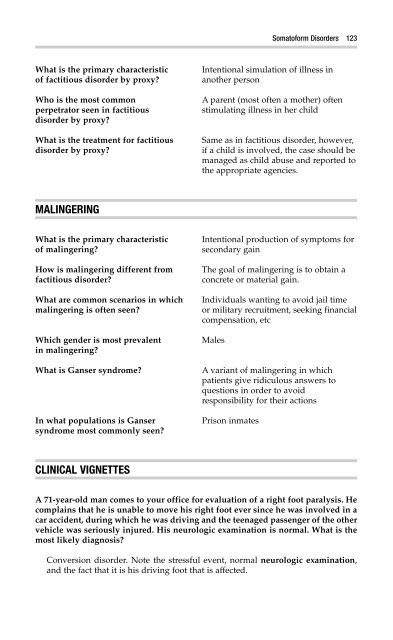Behavioral Science
You also want an ePaper? Increase the reach of your titles
YUMPU automatically turns print PDFs into web optimized ePapers that Google loves.
Somatoform Disorders 121<br />
BODY DYSMORPHIC DISORDER<br />
What is the main characteristic<br />
of body dysmorphic disorder?<br />
Is the defect always imagined<br />
by the patient?<br />
What are the two components of body<br />
dysmorphic disorder?<br />
What are risk factors for the development<br />
of body dysmorphic disorder?<br />
Where do these patients often present?<br />
What are the most common features<br />
viewed as defective in these patients?<br />
What is the most common comorbid<br />
psychiatric disorder associated with<br />
body dysmorphic disorder?<br />
What are some common behaviors<br />
seen in this disorder?<br />
What other diagnoses must be<br />
considered in the differential?<br />
Do surgical procedures and alterations<br />
tend to improve the patient’s view<br />
of his or her physical defect?<br />
What is the recommended treatment<br />
for body dysmorphic disorder?<br />
Preoccupation with a defect in physical<br />
appearance<br />
No. In some patients the defect may be<br />
imagined, but in others an exaggeration<br />
of a true physical feature may be present.<br />
1. Perceptual: Perceptual relates to the<br />
accuracy of the individual’s body.<br />
2. Attitudinal: Attitudinal relates to the<br />
feelings the person has toward his or<br />
her body.<br />
Family history of a mood disorder or<br />
obsessive-compulsive disorder<br />
Often these patients present to<br />
dermatologist and plastic surgeons.<br />
Facial features<br />
Hair<br />
Body build<br />
Depression<br />
Excessive grooming<br />
Avoidance of mirrors<br />
Excessive exercise<br />
Avoidance of public activities<br />
Anorexia nervosa<br />
Gender identity disorder<br />
Narcissistic personality disorder<br />
No. These treatments tend to worsen<br />
the disorder, leading to intensified or<br />
new preoccupations with physical<br />
appearance.<br />
Antidepressants (such as selective<br />
serotonin reuptake inhibitors [SSRIs])<br />
(only if comorbid mental illnesses such<br />
as depression or anxiety are present)<br />
and cognitive behavioral therapy



